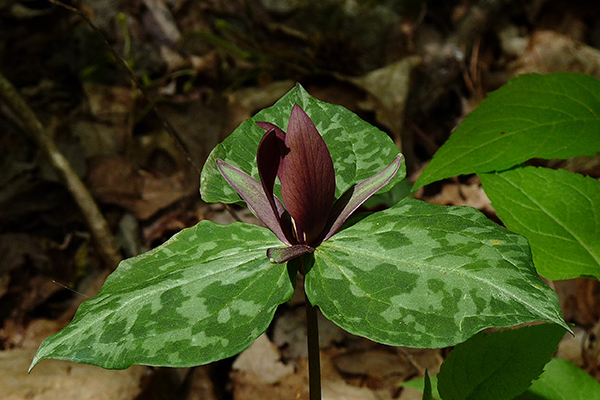By Carol Ann McCormick, Curator, UNC Herbarium.
On a recent Sunday in late March, my husband and I left a neighborhood potluck and headed to RDU for Mark’s 3 p.m. flight to Washington, D.C. Once in the car, we realized we were running about 40 minutes ahead of schedule, so we decided to go for a quick walk on the Piedmont Nature Trails at the Botanical Garden. Mark wanted to see if the Pennywort (Obolaria virginica) was in bloom on the upper part of theOak Hickory Trail. We used the trail along Old Mason Farm Road on the outside of the fence to access the Nature Trails. We enjoyed the chorus frogs and spring peepers singing in the Salamander Pool, checked to see if the pawpaw trees (Asimina triloba) were in bloom in the meadow (not yet), then crossed Meeting-of-the-Waters Creek on the bridge.
Once across the bridge, we enjoyed seeing dozens of little sweet Betsy (Trillium cuneatum) in full bloom. While this plant is native to the Piedmont, we don’t often see it in such numbers as are present on the Piedmont Nature Trails. Mark asked me about the origin of these plants, and I recalled that I had asked Ken Moore the same question a few years ago. Ken Moore was one of the very first employees of the Garden in 1968, and though he retired as the Garden’s assistant director in 2003, he can still be found volunteering at the Garden throughout the year.
In 2016, I was databasing herbarium specimens as part of the National Science Foundation grant to catalog and photograph all our herbarium specimens from the southeastern United States, and I found a specimen of Trillium cuneatumcollected by S. W. Leonard & Ken Moore in 1968 from “Alluvial woods about 1⁄4 mile south of Old U.S. 64 along Swearing Creek” in Davidson County, North Carolina. Later that day, I saw Ken, and he revealed that this herbarium specimen was from the very same population of plants which he had transplanted to the Nature Trails! I took the opportunity to make an annotation label for the specimen which includes the backstory on this herbarium specimen.
“This Trillium cuneatum collection in 1968,” said Ken Moore, “was one of Steve Leonard’s going out and collecting 125 specimens for [University of North Carolina at Chapel Hill] Herbarium’s distribution to other herbaria. Steven Worth Leonard was the Herbarium Curator from 1968 to 1971. Stevie, as Julie Moore and I called him, suggested that I go along to collect some for the North Carolina Botanical Garden. This was before we became purists about conservation through propagation. This was in spring, very early April, just west of Lexington BBQ along the flood plain bottom of Swearing Creek, a mile or so from where Steve Leonard grew up as a kid. We brought those Trillium back in full flower, each one carefully bundled “Al Radford style” in folds of newspaper secured with rubber bands and watered before carefully placed in the big rubber collecting bags. Next day I planted them at the bottom of the Nature Trail slope where big beech trees were located, along the edge of Meeting of the Waters Creek, almost identical to the habitat situation there at Lexington. Those Trillium never skipped a beat and they proliferated and have spread all over the place as you see them throughout the Garden today. Note does need to be made that those Trillium are not native to the Garden, and of all the plants brought from elsewhere in the state and tried along the nature trail, this is the single species that has survived and thrived.”
Nearly 51 years later, Mark and I noted Trillium cuneatum thriving and blooming not only at Ken’s original planting site, but also uphill, upstream, and even on the opposite side of Meeting of the Waters Creek. I had learned long ago that Trillium is dispersed by ants, so how did the plants spread so far? Had ants carried Trillium seeds across the bridges in the Botanical Garden?
Mark Vellend et al. at Cornell University studied seed dispersal of great white trillium (Trillium grandiflorum) and noted that “For the many forest herbs whose seeds are dispersed primarily by ants, there are few documented mechanisms of occasional long-distance dispersal, so models of forest-herb
migration have been largely phenomenological. Here we show that viable seeds of Trillium grandiflorum, an ant-dispersed herb in eastern North America, are dispersed via ingestion and defecation by white-tailed deer. We also use data from the literature on movement patterns and gut retention times to model a deer-generated seed shadow, showing that most seeds dispersed by deer should travel at least several hundred meters from parent plants, and occasionally >3 km.”1 As the Piedmont Nature Trails are well endowed with both ants and deer, it is likely that Ken Moore’s Trillium cuneatum has employed both methods of dispersal.
You can see Trillium cuneatum on the Streamside Trail and Oak Hickory Trail. The Piedmont Nature Trails are open from dawn to dusk every day of the year. You can also see 175 herbarium specimens of Trillium cuneatum, including the one collected by Stevie Leonard & Ken Moore, by visiting the Herbarium in 401 Coker Hall on the main UNC-Chapel Hill campus, weekdays from 9 a.m.-5 p.m.
- Vellend, Mark, Jonathan A. Myers, Sana Gardenscu, and P. L. Marks. 2003. Dispersal of Trillium seeds by deer: Implications for long-distance migration of forest herbs. Ecology 84(4): 1067-1072.
